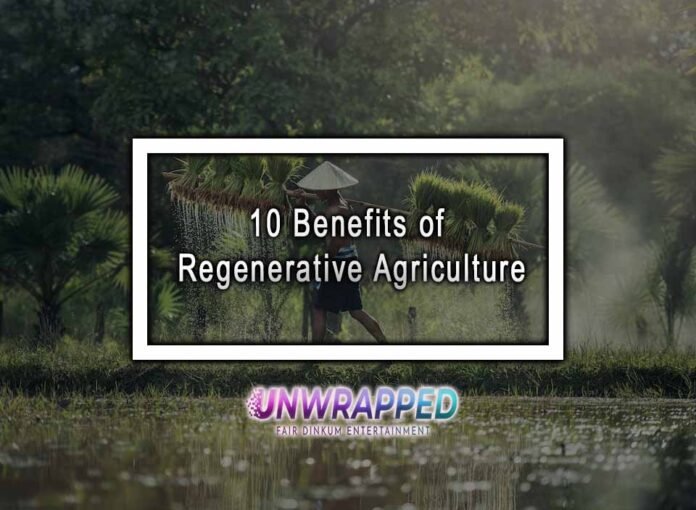The Future is Green: Embracing the Power of Regenerative Agriculture
Regenerative agriculture is more than just a buzzword; it’s a transformative approach to farming that holds immense potential to heal our planet. By focusing on soil health, biodiversity, and ecosystem restoration, regenerative agriculture offers a sustainable path forward for food production. In this listicle, we’ll explore the incredible superpowers of regenerative agriculture and how they are shaping a greener, more resilient future.
1. Carbon Capture and Climate Resilience
Regenerative agriculture acts as a powerful carbon sink, drawing excess carbon dioxide from the atmosphere and storing it in the soil. Through practices like cover cropping, crop rotation, and reduced tillage, regenerative farms help combat climate change by sequestering carbon and improving soil health, making them more resilient to extreme weather events.
2. Soil Regeneration and Nutrient Cycling
One of the fundamental principles of regenerative agriculture is nurturing the soil. By implementing techniques such as composting, crop diversification, and the use of organic matter, regenerative farmers enhance soil fertility and promote nutrient cycling. This approach not only improves crop yields but also reduces the need for synthetic fertilizers, minimizing environmental pollution.
3. Water Conservation and Quality
Regenerative farming practices prioritize water conservation by using techniques like agroforestry, contour plowing, and efficient irrigation systems. These methods minimize soil erosion, increase water infiltration, and improve water quality. By reducing the use of chemical inputs, regenerative agriculture safeguards water resources, benefiting both farmers and ecosystems.
4. Biodiversity and Habitat Restoration
Regenerative agriculture promotes biodiversity by creating diverse habitats and ecosystems on farmland. By integrating native plants, hedgerows, and cover crops, farmers attract beneficial insects, birds, and other wildlife that help control pests and pollinate crops. This holistic approach supports ecosystem resilience, contributing to a healthier and more balanced environment. Implementing these science-based practices can be challenging for farmers to do alone. This is why turning to specialized consultants like ATA Regenerative, or similar others, can be beneficial to receive expert guidance that can help them transition to a more sustainable and biodiverse farming model.
5. Enhanced Food Security and Resilient Supply Chains
In the face of a changing climate and unpredictable global events, regenerative agriculture offers increased food security. By diversifying crops and adopting regenerative practices, farmers can mitigate risks associated with crop failures and market volatility. Furthermore, localized and resilient food supply chains help ensure a steady food supply even during disruptions.
6. Economic Benefits for Farmers
Beyond environmental advantages, regenerative agriculture has economic benefits for farmers. By reducing input costs, improving soil health, and increasing yields, regenerative practices offer a more sustainable and profitable model of farming. Farmers can also tap into niche markets and receive premium prices for sustainably produced goods, fostering long-term economic viability.
7. Reduced Dependency on Chemical Inputs
Regenerative agriculture minimizes the reliance on synthetic fertilizers, pesticides, and herbicides. By adopting organic and agroecological methods, farmers reduce the environmental impact associated with chemical-intensive agriculture. This shift promotes healthier ecosystems, improves human health, and mitigates the pollution of waterways and soil.
8. Community Engagement and Education
Regenerative agriculture encourages community involvement and education. Farmers who embrace regenerative practices often collaborate with local schools, organizations, and consumers to raise awareness about sustainable farming methods. By connecting people with their food sources, regenerative agriculture fosters a sense of responsibility and empowers individuals to make informed choices.
9. Resurgence of Traditional Farming Wisdom
Regenerative agriculture draws inspiration from traditional farming practices and indigenous knowledge. By embracing age-old wisdom, such as intercropping, agroforestry, and rotational grazing, farmers can unlock innovative and sustainable solutions. This revival of ancestral wisdom helps create a harmonious relationship between agriculture and nature.
10. Global Impact and Scaling Up
Regenerative agriculture has the potential to make a significant global impact. As more farmers adopt regenerative practices, the collective effort can restore degraded landscapes, increase food production sustainably, and contribute to mitigating climate change. By scaling up regenerative agriculture, we can build a greener and more resilient future for generations to come.
A Greener Horizon: Regenerative Agriculture Paving the Way to a Sustainable Future
Regenerative agriculture offers a ray of hope in the face of environmental challenges. Its superpowers—carbon capture, soil regeneration, water conservation, biodiversity promotion, and more—prove that sustainable farming practices can transform our world. By embracing regenerative agriculture, we can heal the Earth, secure food for all, and build a future where nature and agriculture thrive in harmony. Let’s join hands and embark on this transformative journey towards a greener horizon.
Read more: Farmers Encounter Various Difficulties and Obstacles










